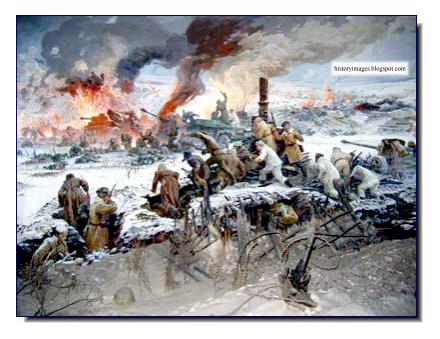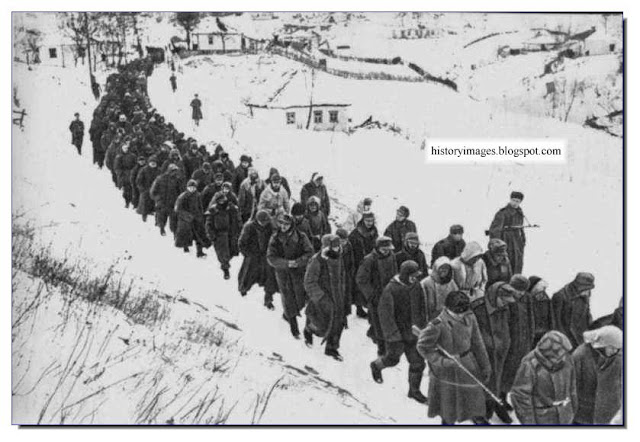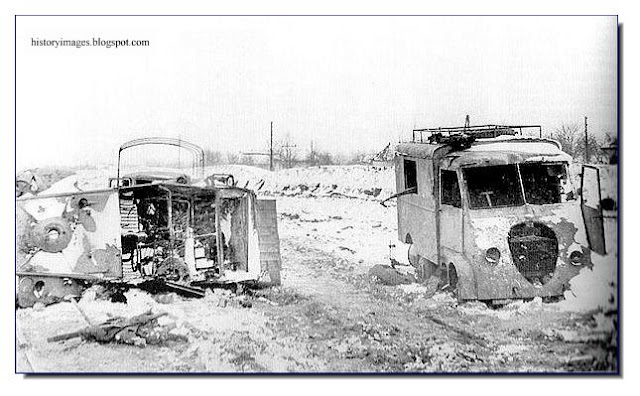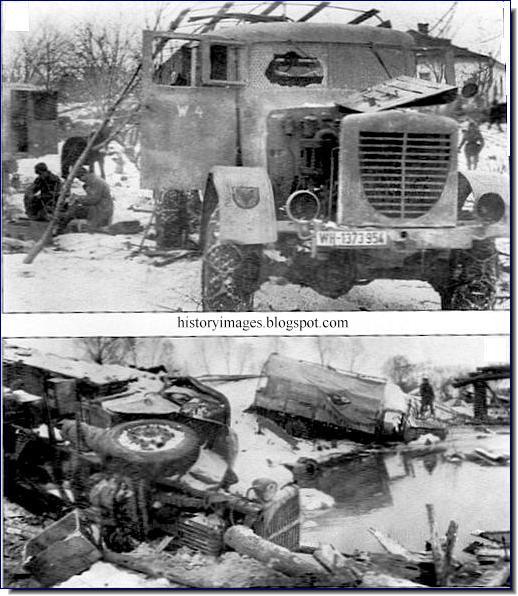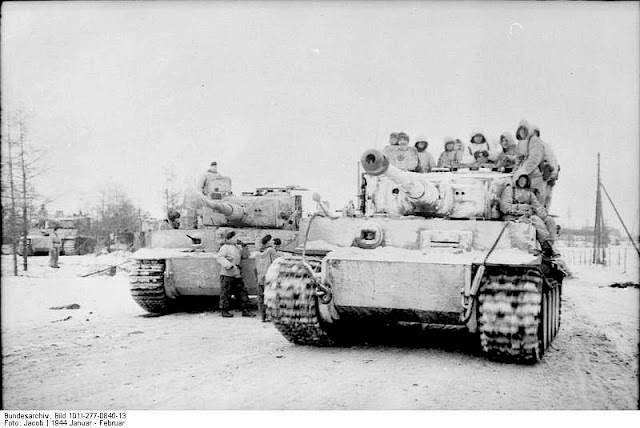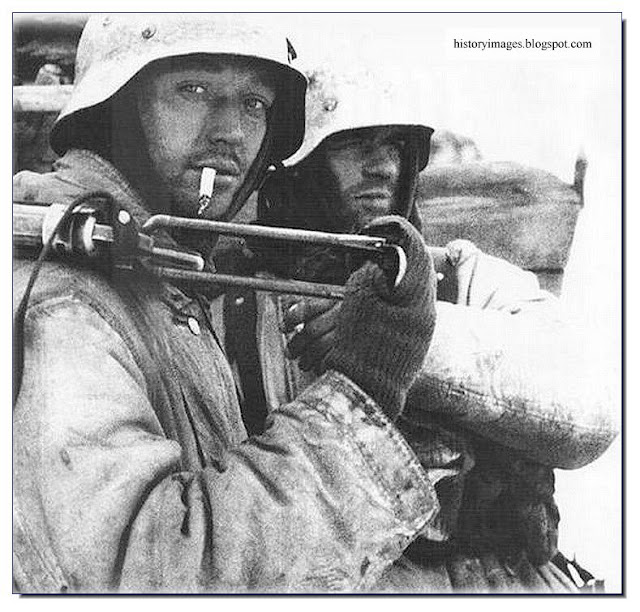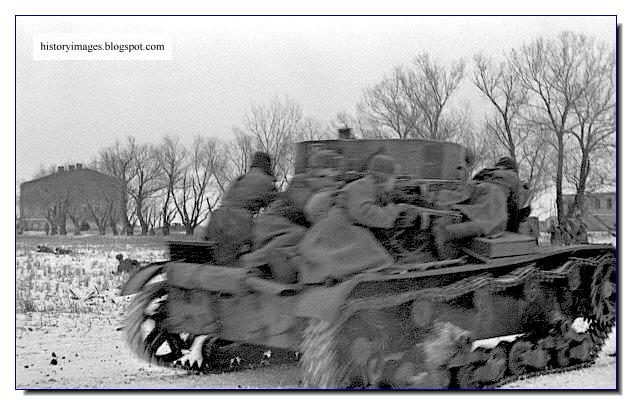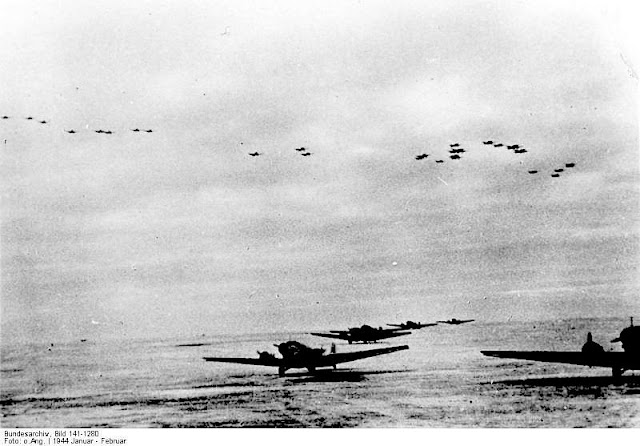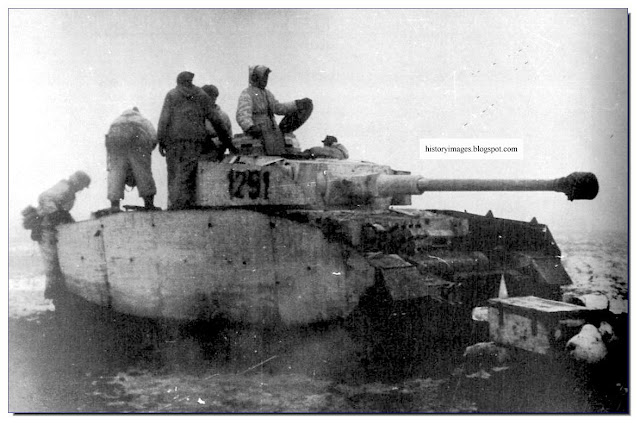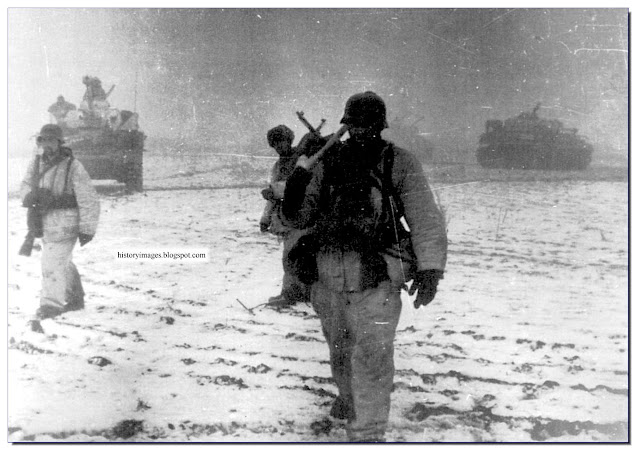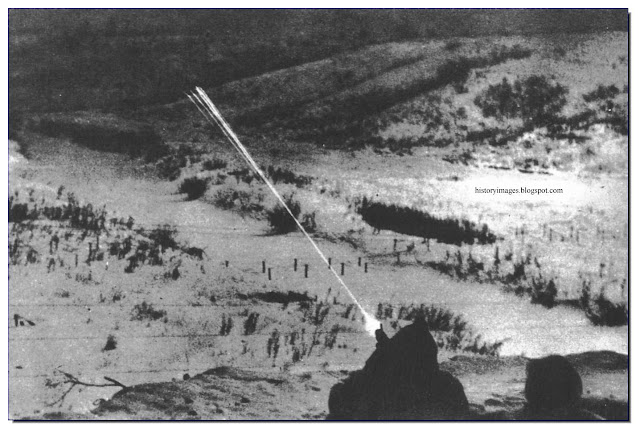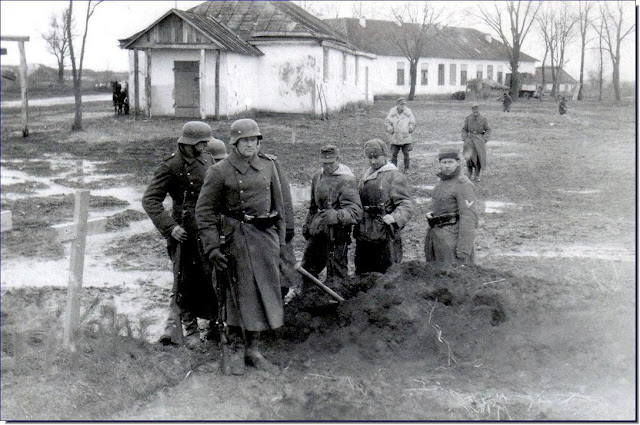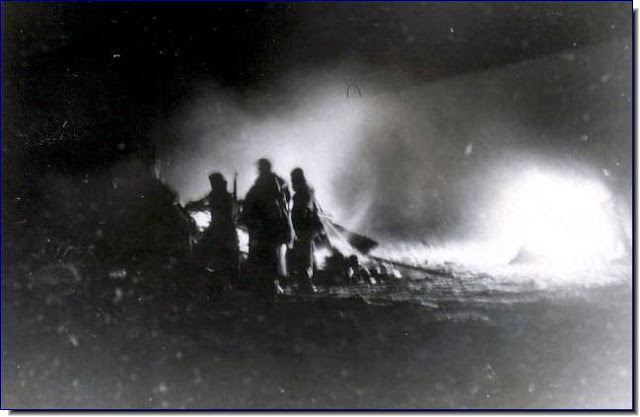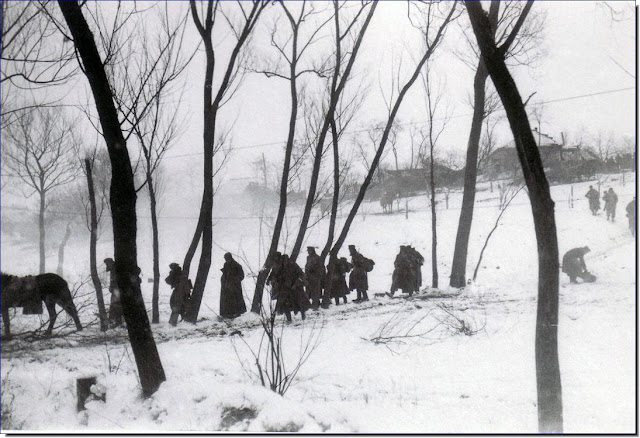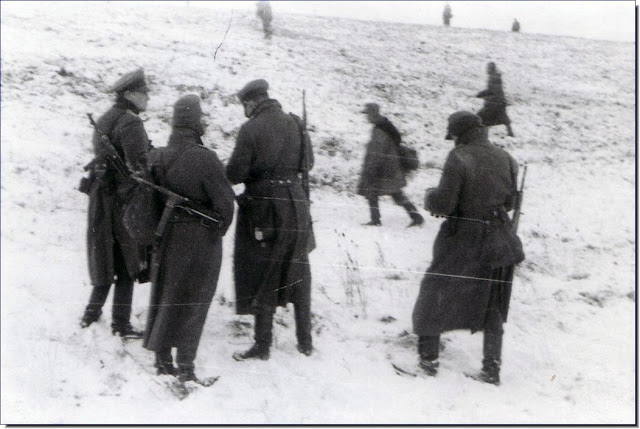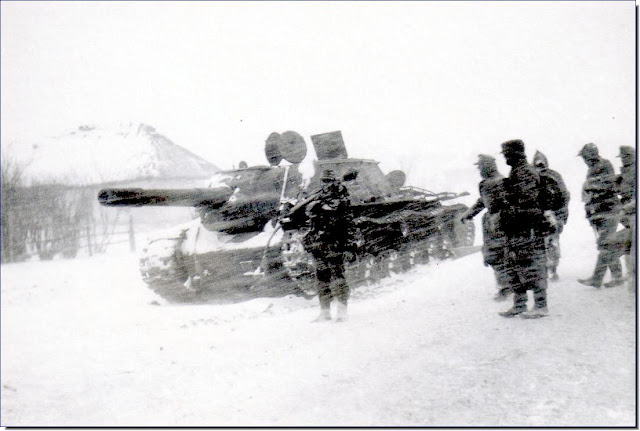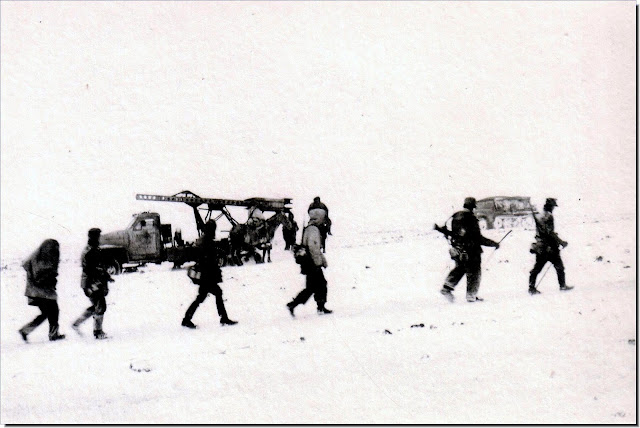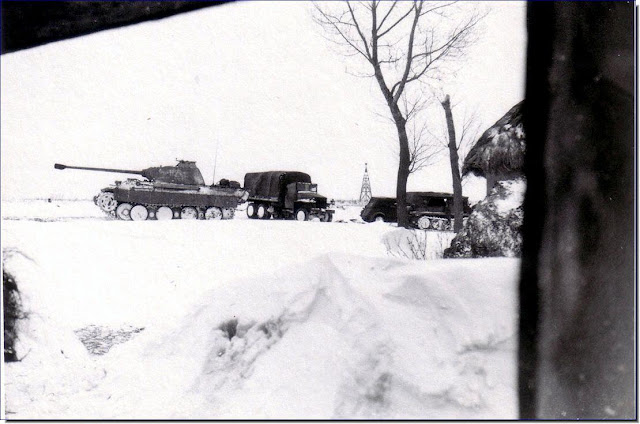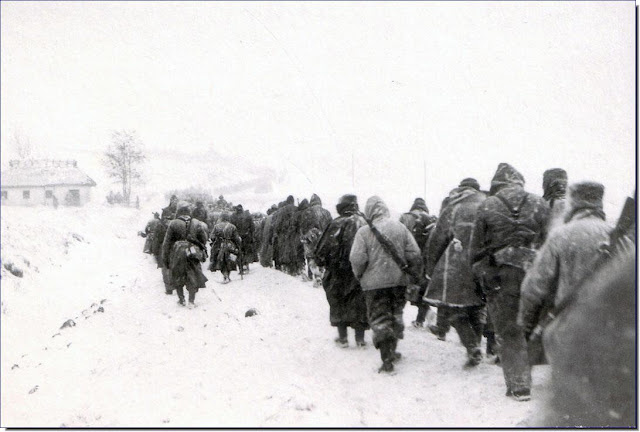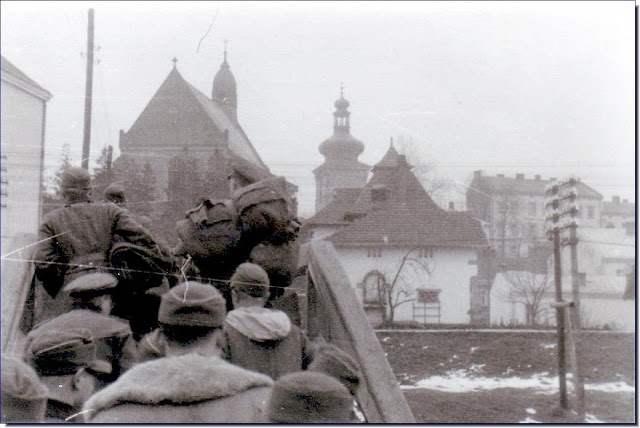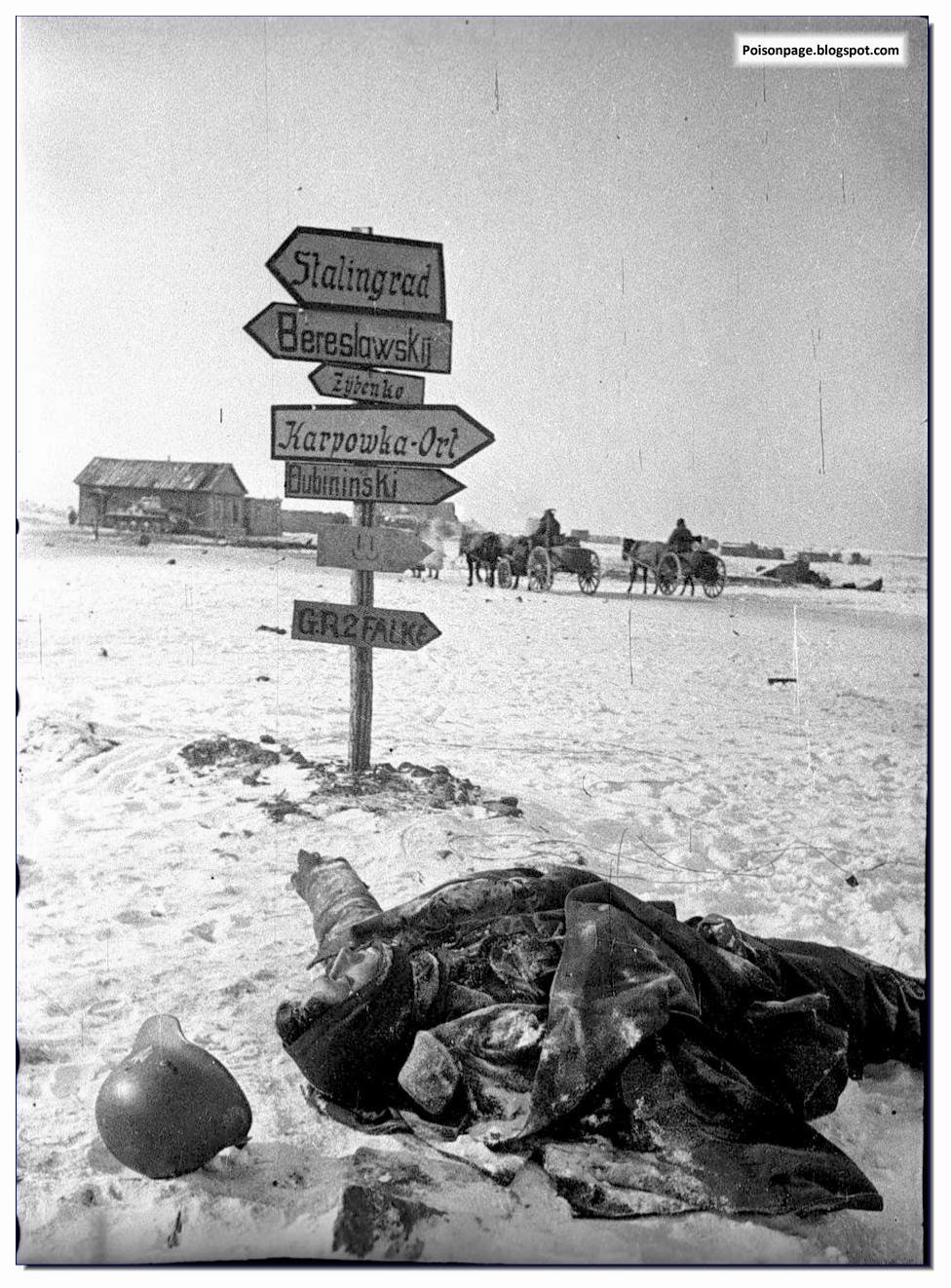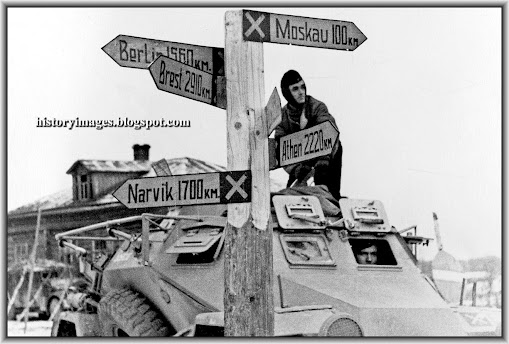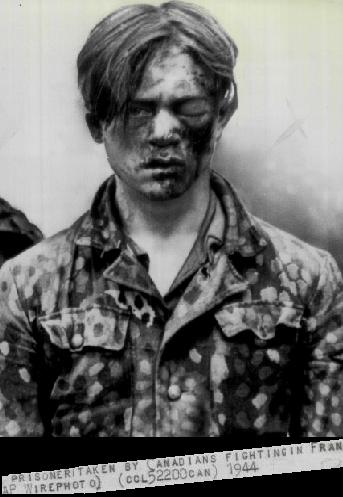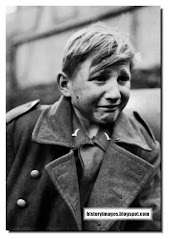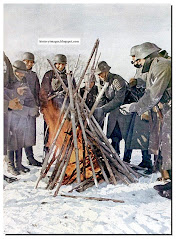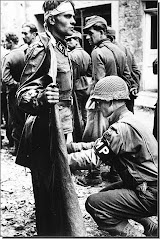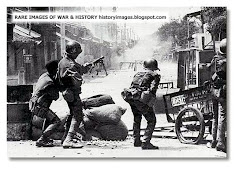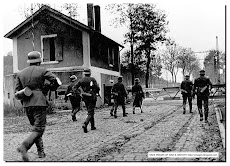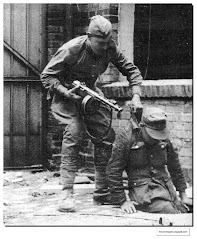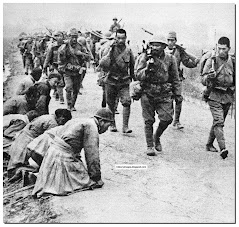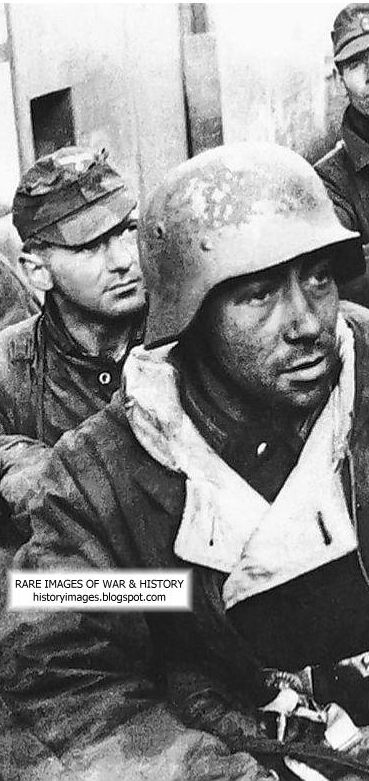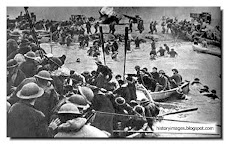1944. The slow decimation of the German Army gained momentum. Battle of Korsun. Or Battle of Korsun-Cherkassy Pocket. Most westerners have not heard of it unless they are history aficionados. The Battle was huge. It could have turned into another Stalingrad. Two thirds of the Wehrmacht trapped in the pocket managed to escape. The rest were killed or captured. Two corps ceased to exist. It was war at its most brutal. Two armies. Equally tough and ruthless. But the Wehrmacht was on the run. In decline.
It was war at its most brutal. Read on....
IMPORTANCE OF KORSUN-CHERKASSY BATTLE
Virtually unknown in the English-speaking world, the Battle of Cherkassy (also known as the Korsun Pocket) still stirs controversy in both the former Soviet Union and in Germany, the protagonists during this epic struggle. Although small in scale when compared to the gigantic battles of Moscow, Stalingrad, and Kursk, theBattle of the Cherkassy Pocket occupies a prominent place in the Russo-German War. It was at Cherkassy where the last German offensive strength in the Ukraine was drained away, creating the conditions for the victorious Soviet advance into Poland, Rumania, and the Balkans during the summer and autumn of 1944. Eclipsed by a war of such gigantic proportions that saw battles of over one million men or more as commonplace, the events which occurred along the banks of the Gniloy Tickich have faded into obscurity. However, to the 60,000 German soldiers who were encircled there at the end of January 1944, this was perhaps one of the most brutal, physically exhausting, and morally demanding battles they had ever experienced. Fully thirty-four percent of them would not escape....
Wiking Waffen SS Division breaks out of the Korsun-Cherkassy Pocket
CRUCIAL BATTLES OF 1944 ON THE EASTERN FRONT
The fate of the German Sixth Army surrounded in Stalingrad was decided in early 1943, marking the turning point in the eastern campaign. From then on the German forces were steadily on the retreat in the face of continual Soviet offensives.
As 1944 began, the superiority of the Red Army had become so crushing, aided by the obstinacy at the highest levels of German command, that the German Eastern Front, which was under heavy pressure everywhere, suffered a number of disasters which cost the eastern armies alone more than half a million German soldiers killed, missing and wounded.
It began with the Korsun-Cherkassy Pocket, where two corps were smashed. Then followed the end of the German forces defending Ternopol, the belated evacuation of the Crimea, the destruction of Army Group Center, the failed breakout of an entire army corps from the encirclement near Brody and the collapse of the entire Army Group South-Ukraine in Romania.
The hundreds of thousands of German soldiers who had to endure this fate were symbols of distress, suffering, sacrifice and death, of fulfillment of duty, courage and comradeship, as well as of fear, desperation and self-sacrifice. It borders on the miraculous that the German soldier continued to stand and hold out despite these bitter setbacks of such enormous proportions.
Cherkassy and Ternopol, Crimea and Sevastopol, Vitebsk, Bobruisk and Minsk, Brody, Jassy and Vutcani entered the history of the Second World War as beacons in a pitiless struggle with tragic results.From Ostfront 1944: The German Defensive Battles on the Russian Front 1944 (Schiffer military history)
By ALEX BUCHNER
MASSACRE AT KORSUN
MASSACRE AT KORSUN
Stalin demanded the speedy "liquidation" of the German forces trapped at Korsun before relief could arrive. General Werner Stemmermann and his remaining units
determined on a final breakout. At 0200 hours on 17 February, as a blizzard raged, Stemmermann's troops finished their last supplies and destroyed guns and
lorries, leaving scenes like this one. There was no place in the columns for the
wounded, who were killed where they lay. As the German column moved into open country, Soviet tanks charged straight into it and Cossacks hunted down and
massacred fleeing Germans
A painting depicting the Russians attacking the encircled Germans in Korsun-Cherkassy
Under the yellow sky of early morning and over ground covered with wet snow Soviet tanks made straight for the thick of the column, ploughing up and down, killing and crushing with their tracks. Almost simultaneously massed Cossack cavalry wheeled away from the tanks to hunt down and massacre men fleeing for the refuge of the hills: hands held high in surrender the Cossacks sliced off with their sabres. The killing in this human hunt went on for several hours and a new round opened on the banks of the river Gniloy Tikich, where the survivors of the first collision of the German column with Soviet troops dragged and fought their way.
— John Erickson, in The Road to Berlin, p. 178.
SOME NOTES FROM THE POCKET.....
German soldiers who were lucky to be alive and taken prisoner
KORSUN: THE SITUATION
http://www.theeasternfront.co.uk/battles/battleskorsunpocket.htm
KORSUN: THE SITUATION
http://www.theeasternfront.co.uk/battles/battleskorsunpocket.htm
During the Russian winter offensive of 1943-44, the German defences on the middle Dnepr had collapsed under enormous enemy pressure. The Russians had forced crossings of the river and continued their advance westward. Only at one point, the 80-mile wide salient between Kanev and Cherkassy, were German forces still holding on to their defensive positions along the western bank of the river.
The German forces in the salient, part of 8th Army, consisted of two Corps, the 11th and 42nd. These two Corps included the 57th, 88th, 72nd, parts of the 389th Infantry Divisions and the 5th SS Panzer Grenadier Division Wiking. In addition was the Korpsabteilung B, made up from parts of the 258th Regiment and the 112th Infantry division, plus various armoured and other supporting units. An airfield at Korsun also provided the possibility that any units that might become trapped could be re-supplied by air.
Despite this, Field Marshal Von Manstein, commander of Army Group South, had requested repeatedly that the two Corps be allowed to withdraw from the salient in order to straighten the German line. However Hitler refused, ordering that the salient be held, despite the risk of encirclement. He proposed that once the Russian offensive had been halted, it would be used as a springboard for an offensive to recapture Kiev.
Stavka saw the opportunity that an encirclement of the forces in the salient provided. Not only would it enable the destruction of a large part of the German 8th Army, but even more appealing was the idea that any retreat by Army Group South could lead to another major German force, Army Group A, being cut off further to the south in the Crimea.
To achieve these goals, the Ukrainian Front Group, led by Generals Konev and Vatutin were tasked to attack the flanks of the salient, from the southeast and northwest. Vatutin's 1st Ukrainian Front consisted of the 1st and 6th Tank and 40th Armies, while Konev's 2nd Ukrainian Front consisted of the 5th Tank and 4th and 53rd Armies. The 27th and 52nd Armies would press the northern and eastern faces of the salient along the Dnepr river positions.
The Germans lost a lot of war material which was destroyed
TRAPPED!
TRAPPED!
The two Ukrainian Front Groups began their attempt to encircle the German forces in the salient on the 24th of January 1944. The forces of the 2nd Ukrainian Front, which attacked from the southeast and drove along the southern side of the salient, made excellent progress, severing the link between the 11th and 42nd Corps and the remainder of the 8th Army.
Meanwhile the 1st Ukrainian Front attacked from the northwest and drove down the western flank of the salient. The German 7th Corps took the brunt of the attack and crumbled under the onslaught. The 88th and 198th Divisions fought desperately against the Russian tanks. These units, with little armoured support, were the only forces available to hold the line. If they failed to do so, the path lay open towards the 5th Tank Army, less than 90km to the southeast. If the two forces were able to link up, the salient would be cut off and the pocket closed.
This was achieved on February the 28th, near Zvenigorodka, when elements of the 6th Tank Army and the 5th Tank Army linked up near the town. The fate of 57,000 German soldiers trapped in the 'Korsun Pocket' now hung in the balance.
Following the closure of the pocket, command of the entire force passed to General Wilhelm Stemmerman and the force within became known as Group Stemmerman. The most rational solution would have been to attempt an immediate breakout, before the encirclement could be secured. In addition to saving the men trapped in the pocket, the void now created between the 1st Panzer Army on the left and the remainder of the 8th Army on the right could be filled.
However Hitler forbade this and ordered that Group Stemmerman hold firm in the pocket. Hitler saw an opportunity to encircle the Russian forces that surrounded the pocket and destroy them, convinced that they were considerably weakened. However the units ordered to carry out this encirclement were at half strength or less, except for the recently arrived 22nd Panzer Division, and even their equipment was badly in need of repair. The German logistical situation was perilous, with men and materials in short supply. Following the debilitating Russian winter offensive, this was compounded by poor ground conditions, constant Russian air attacks on convoys and frequent partisan attacks. German moral was also at a very low ebb. In addition the first week in February saw an early warming of the weather, which proved disastrous to the movement of the German forces.
ATTEMPTS TO SAVE
On the morning of February 4th, General Breith initiated the attack against the Russian forces surrounding the pocket, thrusting from the south with the 16th and 17th Panzer Divisions. However the attack coincided with the start of the dreaded 'rasputitsa' or spring thaw. Movement, where possible at all, was slowed to a crawl and the advance soon became bogged down. To the south of Medvin, the tanks of Oberstleutnant Bake's Heavy Panzer Regiment led the way, with the 34th and 198th Infantry Divisions protecting their flanks. Bake's panzers slowly managed to advance only six miles, against heavy resistance and atrocious ground conditions. Throughout a day of heavy fighting, both sides suffered loss, but the Russians held their ground and the panzers could get no closer.
General Breith though, refused to give up. With parts of the SS LAH Division on hand and the advance elements of the 1st Panzer Division now arriving, he committed them to the action. He radioed the forces in the pocket with the simple message, 'I'm coming!' On the 8th of February the 1st Panzer Division captured Bushanka. Finally, on February the 8th, the Russians were forced into a withdrawal back over the Gniloy Tikich River where the 16th and 17th Panzer Divisions were able to establish a small bridgehead. However poor ground conditions and stiff Russian resistance halted any further advance there. The German forces trapped in the Korsun pocket would have to fight their way out to them.
On the 12th of February, the SS LAH Division battled against Russian forces at Vinograd, while the 16th Panzer Division encountered resistance on the road to Medvin. The 17th Panzer Division also became engaged in a tank battle against elements of the Russian 6th Tank Army to the southwest of Medvin. The 1st Panzer Division meanwhile, continued to press its attack towards Lysianka. Further north, elements of the 47th Panzer Corps stalled at Zvenigorodka, 30km from the pocket and 25km from the 3rd Panzer Corps, its strength expended.
General Breith though, refused to give up. With parts of the SS LAH Division on hand and the advance elements of the 1st Panzer Division now arriving, he committed them to the action. He radioed the forces in the pocket with the simple message, 'I'm coming!' On the 8th of February the 1st Panzer Division captured Bushanka. Finally, on February the 8th, the Russians were forced into a withdrawal back over the Gniloy Tikich River where the 16th and 17th Panzer Divisions were able to establish a small bridgehead. However poor ground conditions and stiff Russian resistance halted any further advance there. The German forces trapped in the Korsun pocket would have to fight their way out to them.
On the 12th of February, the SS LAH Division battled against Russian forces at Vinograd, while the 16th Panzer Division encountered resistance on the road to Medvin. The 17th Panzer Division also became engaged in a tank battle against elements of the Russian 6th Tank Army to the southwest of Medvin. The 1st Panzer Division meanwhile, continued to press its attack towards Lysianka. Further north, elements of the 47th Panzer Corps stalled at Zvenigorodka, 30km from the pocket and 25km from the 3rd Panzer Corps, its strength expended.
Dead German soldiers who were massacred when they tried to break out
General Stemmerman quickly realized the seriousness of the situation. Only quick and decisive action could save the situation from becoming a major disaster. The forces in the pocket would have to be rescued soon, but first the pocket would have to hold firm. To accomplish this, the establishment of new fronts was initiated at possible breakout points, mostly along the southern edge of the pocket.
Initially most of the German forces were facing north and east, along the Dnepr River. Units would have to be repositioned to secure the perimeter of the pocket.
Orders were received from 8th Army, 'Group Stemmerman will shorten the front lines and move the pocket in the direction of Shenderovka in order to be able, when the time comes, to break out towards the forces mounting a relief attack from outside.'
This would require a masterful handling of the forces within the pocket. Stemmerman took on the task with a vengeance and successfully contracted the northern edge of the pocket, with 42nd Corps abandoning the Dnepr River positions. At the same time, the pocket was extended to the south by 11th Corps, with the objective of capturing the key villages of Shenderovka, Novaya-Buda and Komarovka.
The focal point of all activity was Korsun, which lay in the centre of the pocket and provided the pocket's only airfield. Here supplies were flown in and casualties flown out, by up to 70 aircraft per day, as the weather permitted. It was the only contact that the German forces had with the outside of the pocket, with the exception of radio communications.
A dead German soldier in the snow
THE POCKET MOVES FROM KORSUN TO SHENDEROVKA
THE POCKET MOVES FROM KORSUN TO SHENDEROVKA
At Novaya-Buda the severely weakened 105th Regiment of the 72nd Division was tasked with assaulting the village. The Regimental commander, Major Kaestner, knowing he would have to cross an open slope to reach his objective, chose to make a night attack. The attack was made on the night of February 11th. Moving silently with bayonets, knives and entrenching tools, the men of the 105th crept toward the Russian positions. They could hear enemy soldiers chatting and an occasional burst of laughter. Suddenly, they were challenged by a Russian sentry. The regiment charged the surprised enemy, firing as they ran. Fighting was fierce as shock troops roved up and down the trenches finishing what remained of the Russian resistance.
On the 12th of February, Korsun was abandoned, along with its precious airfield. Almost 3000 wounded men were left behind there with medics to await capture by the Russians. No further supplies were received or wounded airlifted out after this date. On the 13th, inside the pocket, the 105th Regiment took 240 prisoners and destroyed 21 tanks in an assault on the village of Komarovka, but suffered heavy losses maintaining control of the town. The village of Shenderovka was taken later that afternoon, securing the planned breakout area.
By February 15th, the pocket had moved with a masterful fluidity, maintaining its flanks against constant Russian pressure, not only from the pursuing ground forces but also from constant air attacks, to the jump-off point at Shenderovka. The same day, the 105th Regiment captured the village of Chilki, and then repulsed heavy Russian counter-attacks. The pocket was now centred on the village of Shenderovka and had been reduced to an area of 56sq km, containing around 40,000 men.
By February 15th, the pocket had moved with a masterful fluidity, maintaining its flanks against constant Russian pressure, not only from the pursuing ground forces but also from constant air attacks, to the jump-off point at Shenderovka. The same day, the 105th Regiment captured the village of Chilki, and then repulsed heavy Russian counter-attacks. The pocket was now centred on the village of Shenderovka and had been reduced to an area of 56sq km, containing around 40,000 men.
German POW after the Battle of Korsun
On the 15th of February, Panzers from the 3rd Panzer Corps made one last push from their bridgehead on the Gniloy Tikich, to capture Hill 239, northwest of the river. The area of the hill was held by elements from the 6th Tank and 27th Armies. But by this time the Russians had prepared strong defensive positions and were continually being reinforced.
Despite their best efforts the tanks of the 1st and 17th Panzer Divisions were unable to capture the hill, their advance grinding to halt along a line formed by the towns of Lysianka, Oktyabr and Chishintsy, about 12km short of the objective.
This meant that the men trapped in the pocket would have to fight their way out against Russian infantry supported by armour, in well prepared positions. The Russians occupied two sets of positions, the inner ring facing Group Stemmerman and an outer ring that was holding off the 3rd Panzer Corps efforts to break through.
On the same day 8th Army issued new orders to the forces trapped in the pocket, 'Group Stemmerman must perform a breakthrough as far as Zhurzintsy/Hill 239 by its own effort. There it will link up with the 3rd Panzer Corps.'
However the message did not clarify that Hill 239 was still in Russian hands. Stemmerman concluded from the message that friendly forces held the hill. He immediately began preparations for the breakout. Stemmerman would remain with the rearguard troops and General Lieb would lead the breakout. Once it began, however, there would be little communication between units. Local commanders retained strong discipline among individual units.
THE BREAKOUT
By the 16th of February, the besieged forces of Group Stemmerman had been under siege for almost three weeks and the situation was becoming more desperate with each passing day.
Fearing that Hitler might postpone the breakout and knowing of the steadily weakening condition of the forces inside the pocket, Von Manstein made the decision to order General Stemmerman to begin the breakout attempt. The codeword was Watchword Freedom. His communiqué stated simply, 'Watchword Freedom, objective Lysianka, 2300 hours.' After issuing the order to break out, Manstein had attempted to warn Stemmerman that Hill 239 was still in enemy hands. But all radios had been destroyed and there was no further communication with the trapped troops.
Within minutes, Stemmerman's chief of staff, Colonel Franz, had read the message. The entire force was advised and the battle plan for the breakout, involving a three-pronged attack by the group, was put into action.
To the northwest, Corps Detachment B would lead the right wing of the breakout. In the centre, the 105th Regiment would again lead the way. Their success at Novaya-Buda had earned them the respect of the entire group.
The southwestern effort would be lead by elements of the 5th SS Wiking Division. General Stemmerman would remain with the covering forces and control the withdrawal. All unnecessary items of heavy equipment were left behind.
At 03:30 hours the breakout commenced. The 105th Regiment moved silently in the darkness until they reached the base of Hill 239. A reconnaissance patrol led by Lieutenant Bender moved ahead to scout out the area. It was hoped that he would make contact with units of the 1st Panzer Division. However Lieutenant Bender soon returned with grim news. 'There are tanks ahead, but not ours. A half dozen T-34s are stationed on the road ahead and there are more further to the west.' The way was not open after all and the lead units realised that they would have to fight through the Russian positions before reaching the safety of 1st Panzers positions.
Major Kaestner reorganized his force and readied them for a swift assault. Kaestner's men moved silently towards the Russian position once again. Again they assaulted with bayonets, knives and entrenching tools. The Russian infantry fled firing wildly into the darkness. However this only alerted the tank commanders who quickly turned on their vehicle searchlights, illuminating the fleeing mass of German troops.
Now there was no orderly movement, it was every man for himself. All along the line the German units moved frantically ahead, suffering horrendous casualties. They had no choice but to move forward.
The units of the 1st Panzer Division and Bake's Heavy Regiment, hearing the carnage moved forward to offer what help they could.
All that remained of the 105th Regiment, about 220 men from an original compliment of 1100, finally reached their rescuers at Lysianka. Loudly shouting the password, 'Freedom, freedom!' they were greeted by Lieutenant Freiherr von Dornberg, who welcomed Kaestner with an embrace.
Meanwhile A renewed Russian attack on the German rear was repulsed by the 5th Panzer regiment of the Wiking division, which was itself completely destroyed in the process.
During the day General Stemmerman had been killed by anti-tank fire as he attempted to change command posts and General Lieb had assumed command.
Leon Degrell, serving with the Wallonian Brigade, part of the SS Wiking Division, described the ensuing panic. 'In a frantic race to escape, some carts carrying the wounded overturned. Suddenly a column of Russian tanks appeared and drove over the carts, smashing them one by one like boxes of matches. They machine gunned the horses and ran over the wounded crushing them beneath their tracks.'
The relief attempt begins. Tanks and halftracks of 1st Panzer Division begin movements towards the pocket, early February 1944
Amongst the chaos, men from the 3rd Company of the 389th Panzerjaeger Battalion, saw the calamity unfolding. Staff Sergeant Krause who was leading the Company ordered his men into action. They moved quickly to the top of a nearby hill with some panzerfausts, finding seven T-34's firing down on the columns. They fired at the nearest vehicles, destroying two of them. The remaining vehicles, unable to see where the attack had come from, panicked and moved away.
Elsewhere a column from the Wiking Division was under attack from Russian tanks when a roaring cheer was heard. To the columns amazement, an officer on horseback appeared from a nearby ravine leading a force of some 3000 men. The man on horseback was Lieutenant Colonel Muller, waving his men forward as they smashed into the Russian lines. Even though dozens fell to concentrated gunfire the enemy line was broken and moved away. The men that were left moved on into the woods and headed toward the river.
Colonel Franz had witnessed the slaughter of the wounded of the Wiking Division and had a horse shot out from under him during the melee.
Proceeding on foot, he joined up with another group of soldiers and moved with them. Suddenly rifle and machine gun fire broke out in front of them. Two soldiers of the Wallonian Brigade appeared. They warned of a Russian machine gun position blocking the way in front of them. Franz quickly grabbed a sniper rifle and moved forward towards the enemy position. With his telescopic sight, the Colonel sighted three enemy soldiers manning a machine gun. Taking quick aim, he snapped off three shots, killing them all. Franz stood, and waved the remainder of his group forward.
Tiger tanks of the 3rd Panzer Corps. Korsun-Cherkassy. February 1944
CROSSING THE GNILOY TIKICH RIVER
CROSSING THE GNILOY TIKICH RIVER
By late morning, the escaping troops of Group Stemmerman had reached the bank of the Gniloy Tikich River. The early thaw had raised the level of the river and increased its flow into a roaring torrent, which now blocked their way. The waterway was 30 yards wide and about six feet deep. There was no bridge to be seen and crossing it seemed impossible.
Unknown to the group, about a mile to the northwest, the 1st Panzer division had a bridge under their control and the engineers of the Jena Armoured Engineer Battalion had also erected a smaller footbridge.
As the first arrivals milled around the river, the first T-34's appeared in the distance. Firing high-explosive shells and ricocheting airbursts, they caused panic. For many, the choice was clear. They would either have to brave the strong current or die where they stood.
Whole groups of men jumped in and began to try to cross. Many were swept away by the current, or dragged under by the weight of their uniforms and drowned. Men began to strip in order to improve their chances of survival. However those who reached the other side were suffering terribly from the cold, the temperature that morning was -5°C. The men still had over a mile to walk through the snow before they reached the safety of the German lines.
Some units attempted the crossing in some semblance of order. General Herbert Gille, commander of the Wiking Division, ordered that a tractor be driven into the middle of the river to act as a temporary pier, but the tractor was soon swept away. He then organised human chains, alternating a swimmer and a non-swimmer to extend across the river. It worked well until the numbing effects of the water caused a man to lose his grip. Suddenly the chain was broken and the surging currents carried the men away.
Once the first survivors reached the first positions of the LAH and 1st Panzer Divisions, they realized the desperate situation unfolding to their south. One group on the other side of the river moved to help in bringing some of the refugees to the crossings to their north. A group of tanks and engineers immediately went to the crossing site further south to assist their fellow soldiers.
The crossings continued throughout the day. Rear guard units of the Group pulled out successfully and made the crossing. By the end of the 16th, most of the fighting at the river had ended and the majority of the survivors from the pocket were across. The German lines had been straightened and nearly 35,000 of the original 56,000 men were saved. Over 10,000 men were killed and another 17,000 captured.
CONCLUSION
The Russians were now becoming skilled in the execution of the sustained all arms offensive. Their troops were now more experienced and better equipped with simple and effective weaponry. Their overwhelming resources of manpower and determination to rid the Motherland of the hated German invader were beginning to exact a heavy cost on the German army.
The German forces were hampered by Hitler's continual interference. His repeated reluctance to give up ground in order to improve the tactical situation doomed the two Corps trapped in the salient. Hitler's inaccurate view of the situation belied the fact that most of his Divisions were badly under strength, poorly equipped and exhausted.
The Luftwaffe was again unable, as at Stalingrad, to re-supply the forces trapped in the pocket by air. Russian air superiority and a lack of fighters to support the transports lead to heavy losses. Poor ground conditions, as so often during the Russian campaign, badly affected German mobility. This debilitated offensive operations outside the pocket and the ability of the forces inside the pocket to manoeuvre.
While the Russians had not succeeded in destroying the two Corps trapped in the pocket, they had successfully neutralized the fighting ability of over six German divisions. Most of the men rescued had no weapons and all their heavy equipment had been abandoned. German forces had lost their foothold along the Dnepr.
The Russian forces would regroup and prepare for a new offensive during the summer. Operation Bagration, against German Army Group Centre, which would drive the Germans out of Byelorussia.
The German forces were hampered by Hitler's continual interference. His repeated reluctance to give up ground in order to improve the tactical situation doomed the two Corps trapped in the salient. Hitler's inaccurate view of the situation belied the fact that most of his Divisions were badly under strength, poorly equipped and exhausted.
The Luftwaffe was again unable, as at Stalingrad, to re-supply the forces trapped in the pocket by air. Russian air superiority and a lack of fighters to support the transports lead to heavy losses. Poor ground conditions, as so often during the Russian campaign, badly affected German mobility. This debilitated offensive operations outside the pocket and the ability of the forces inside the pocket to manoeuvre.
While the Russians had not succeeded in destroying the two Corps trapped in the pocket, they had successfully neutralized the fighting ability of over six German divisions. Most of the men rescued had no weapons and all their heavy equipment had been abandoned. German forces had lost their foothold along the Dnepr.
The Russian forces would regroup and prepare for a new offensive during the summer. Operation Bagration, against German Army Group Centre, which would drive the Germans out of Byelorussia.
Germans escaping from the encirclement
SOME NOTES FROM THE POCKET.....
From Ostfront 1944: The German Defensive Battles on the Russian Front 1944 (Schiffer military history)
By ALEX BUCHNER
February 7: In spite of everything, order and discipline reign in the pocket. All movements are carried out calmly and according to plan. Rearguard and flanking cover fight almost to the precise moment of the next withdrawal. Gaps in the front are closed.
February 8: The enemy is attempting to reduce the pocket from all sides.
February 9: Our withdrawals are considerable. The surrounded divisions give up more ground in the southeast, east, north and northeast. The pocket has already shrunk considerably.February 10:Rescue appears ever more questionable. The surrounded units are nearing the end of their strength. There is little ammunition and no regular rations. The men are dead tired and have been completely soaked for days. Even by the most optimistic view the collapse is only a few days away.
February 10/11: The night again passes with numerous, difficult battles, rain and deep, clinging mud.
February 11: At 1100 two very correct Russian officers appear in front of our sector carrying a message from the Soviet High Command to the commander of the surrounded German units. The message is a final ultimatum - either we surrender or the final measures to destroy the pocket will begin at 1300. A prime-mover takes the officers through the mud back to the Russian lines.In the afternoon the enemy attacks from all sides. We must get out of the pocket. When will the order come to break out?
February 12: Despite all their efforts of the last 14 days the Russians have had nosuccess, now they want to accelerate the finishing of the pocket. Aftertheir ultimatum is rejected out of hand begins the assault on all sectors.Once again heavy rain, mud, wet, filth, trenches and holes filledwith water.The pocket has become extremely small, territory will definitelyhave to be won in the south and southwest in the direction of the plannedbreakout.Superhuman efforts are demanded of the troops. Every few minutesthe enemy breaks through the positions somewhere, counterattackshave to be carried out and enemy penetrations sealed off.The field bakeries in Korsun bake the last bran-bread. Togetherwith the small packets of concentrated chocolate dropped with thesupply canisters it is the only rations issued after February 13 ..."
German snipers at Korsun
February 13: A several-kilometer-long lake southeast of Korsun ends in a tremendous dam. The troops evacuating Korsun have to cross the lake overan almost kilometer-long wooden bridge which the pioniers have built along the top of the dam. Everything is going smoothly despite the giant chain of men and vehicles. The cold has set in again and the mud has frozen. Everywhere people are trying to get vehicles going or arepushing them to the side so as not to block the road and hinder the panje wagons which, pulled by small horses and oxen, can get through more
easily.
February 14: The news of our relief advance is totally inaccurate. In the north of
the pocket we are withdrawing alarmingly, but scarcely advancing in the
south. The Russians, who are staying on the heels of the rearguard, pushed into Korsun early this morning. The village of Novo Buda in thesouth must be held no matter what, it forms the left pillar of the breakout area. If the enemy takes back Novo Buda he will only have to advance 6 kilometers to the west to cut off everyone near Shenderovka.The men in their dirty, mud-covered winter uniforms are totally exhausted. There is almost nothing to eat and only dirty water from the sides of the road to drink. The only heat for warming and drying outcomes from meager fires made from corn husks. Added to this is the mental strain.The weather has changed, the rain has stopped. The wind whistles and the onset of the cold brings snow.
February 15: Shenderovka, the breakout gate, has finally been taken following three days and two nights of fighting. In our rear, on the other hand, the Russians have pushed far beyond Korsun. The worst thing is the rations. We have no more, nothing at all. The last supplies were issued in Korsun. The men, without sleep and shivering from the cold, have received nothing, hot or cold, for threedays, and are living off what they have with them.A collective farm which has been transformed into a field hospitalis hit by fire from a Stalin Organ. Dozens of wounded create a bloody shambles. More than 1,200 wounded have already spent several days and nights in the open in straw-filled, light panje wagons requisitioned from villages in the pocket. After the rain of the previous weeks they have become soaked to the skin; now they must face the biting cold and lie half-frozen beneath their snow-covered blankets. One scarcely hears any moaning or groaning; many have given up, and no longer ask for anything. As soon as one dies he is laid beside the wagon by the Russian volunteers detailed as drivers and his place is taken by a new casualty.There are no more medicines and dressings are in short supply. The
doctors do all that is within their power, but they cannot help many. They
do it to satisfy their consciences.In the north the enemy continues to press and is already three kilometers from Shenderovka ..."
German snipers in action
Wednesday, February 16: Shenderovka had become a gate to hell. The way to the assembly areas led every unit through the village with its one through-road, the sole approach road for the first three divisions, all of the train units and the rear-echelon services of both corps. Movement was slow and laborious over the muddy, rutted and worn surface.The endless columns of marching men and motor and horse-drawn vehicles became wedged together, resulting in a tremendous traffic jam. Since the Russian shad a clear view into the pocket and the movements inside could not be concealed,directed artillery fire, as well as fire from heavy mortars and Stalin Organs, fell continuously among the halted and slow-moving masses, inflicting further heavy casualties. Shells and howling rocket projectiles impacted everywhere. The single road was soon blocked by shattered vehicles, dead horses, exploding munitions vehicles, burning trucks, heaps of dead and wounded, shattered remains of walls and burning wooden houses. It was a hellish scene filled with bursting shells,smoke and dust, the cries and moans of the severely wounded, and the roar of German artillery as it fired its last rounds before spiking its guns. Anti-aircraft guns roared as enemy aircraft strafed and bombed the columns. And all the time fresh units continued to move into Shenderovka from the north, east and west. There was no way around the town and the only chance for freedom lay to the southwest
BREAKOUT AND THEN NIGHTMARE....
When morning dawned the men of the break-out force realized to their bitter disappointment, and even horror and dismay, that it was not the tanks of the German relief force which were waiting for them on both sides of Hill 239, but a fully alerted enemy.
Russian tanks, anti-tank guns and artillery fired into the already confused and exhausted elements of the first wave and the steadily growing stream of approaching columns from the second and third waves.Everything became inextricably entangled, was seized by an unholy disorder and began to disintegrate. Any semblance of command ceased to exist. Horse-drawn vehicles were smashed, horses ran away and bogged-down vehicles went up in smoke and flames. Men ran about seeking cover in the mostly open terrain.Clusters of men ran forward with loud shouts, trying to get through, while others sought refuge in the deep, snow-covered ravines or in clumps of trees. Increasingly heavy fire smashed into the dense masses, which at first stayed put as if stunned and apathetic. Many grenadiers tried to fight back. Apart from Panzerfaust rocket launchers, however, they had no effective weapons against the enemy tanks which appeared everywhere.
Despite their teams of eight and ten horses the German antitank and light field guns had been left behind on the smooth, icy slopes or had become bogged down. Some Russian tanks were destroyed by the Panzerfaust antitank rockets. Two men of the 389th Anti-tank Battalion, which had long since been without guns, disabled five tanks. The others turned away. However, more tanks appeared and the enemy fire became ever heavier. Until now the troops had dragged all of their heavy weapons along with them, but now they were left behind, light and heavy field guns, as well as mortars and machine-guns.
The fate of the wounded in the panje wagons was also decided here; they, too, had to be left behind. And the enemy knew no pity. Oberst Franz, Chief-of-Staff of XXXXII Corps, saw about 15 Russian tanks roll through a ravine in which a column of panje wagons carrying wounded had stopped. The Russians shot the horses with machine-guns and crushed the wagons beneath the tracks of their tanks. Of these130 seriously-wounded men of the Wiking Division Dr. Thon was able to rescue perhaps a bare dozen.
Approximately 140 other seriously-wounded men had been taken along in the division's tracked vehicles. These were shot up by Soviet tanks west of Shenderovka. Doctor Isselstein was killed by fire from a T-34. A column carrying wounded from the Wallonie Brigade also failed to get through, as did several others.
Soviet troops ride a light tank into battle to clean-up the Germans in the Korsun pocket
CROSSING THE RIVER GNILOY TIKICH....
CROSSING THE RIVER GNILOY TIKICH....
There was no bridge, and there were no boats to be seen anywhere.
In the course of less than half an hour about 20,000 men had assembled at the bank. They had no idea where the leading elements of the relief force were, they were unaware that
Oberstleutnant Dr. Bäke and his heavy panzer regiment had set out again that morning to relieve the pocket and in the course of the day even reached the fateful Hill 239 south of Dzhurzhentsy, they did not know that German panzer grenadiers were holding Oktyabr to cover their withdrawal", and they did not know that only three kilometers upstream lay Lysyanka, in which the 1stPanzer Division had built a bridge and a footbridge for them.
They had gone further south then the defenders of the Lysyanka bridgehead could have expected. It was about eleven in the morning. Everyone was deliberating how to cross the stream. Generals Lieb and Gille and Oberst Dr. Hohm arrived and attempted to establish a semblance of order and organize a crossing. A heavy tractor was driven into the river to serve as the basis for a crossing. It was rolled away by the current, however, and other pieces of equipment which had been pushed in behind it were also swept away. The men formed teams of swimmers and non-swimmers, but the non-swimmers were pulled away by the current and went under. Many tried to ride across on horses and were swept downstream, others crawled out onto the ice and went through. Still others took off their uniforms, bundled them up and threw them across to the other side and then tried to swim across, usually in vain.
The temperature at the time was minus five degrees and the area was being swept by an icy wind.
Then the pursuing Soviet tanks reached the area of the river. The first four T-34s drove to within a few hundred meters and began firing into the masses of men with machine-guns and high-explosive shells. There was no stopping now - they had to get to the other side where the Russians could not follow. Once again the result was a terrifying scene. In groups of thirty to forty, the frozen, half-starved soldiers plunged into the ice-cold water and tried to fight their way through the rushing torrent. Heads and arms poked up between the ice floes, cries for help rang out, bodies of horses and men floated and sank in the current. The Generals, too, were swimming.
Oberst Dr. Hohn, the commander of the 72nd Infantry Division, waited completely soaked in the freezing cold on the far bank until the last of his men arrived. Still on the other side, however, were the wounded, who could not cross. The entire bank was littered with discarded small arms, items of equipment and parts of uniforms. For those who were fortunate enough to make it across, as soon as they emerged from the water the uniforms froze to their bodies. And they had still not reached safety. The long, open line of hills south of Lysyanka lay under artillery and tank fire. Under enemy fire, thousands of men, some in frozen uniforms, some half dressed and some completely naked, ran through the snow toward the distant houses of Lysyanka-East. Hundreds of German soldiers who had previously escaped death lost their lives at the Gniloy Tikich, a few hundred meters from the forward outposts of the1st Panzer Division. They died with freedom in sight, the freedom of which they had been dreaming for weeks and for which they had held on.
German Stuka Dive Bombers (JU-87) at Korsun airfield
CONCLUSION
CONCLUSION
It had not become a second Stalingrad, but two German army corps had ceased to exist and the better part of six divisions, which were soon to be bitterly needed,had been destroyed. Having escaped a twenty-one day battle of encirclement, the ten-thousand German soldiers were not fit for action for some time, and their faith in the highest levels of German command had been severely shaken. The two corps had also lost their entire complement of armaments, equipment, vehicles and horses.
Wiking Waffen SS soldiers at Korsun
WIKING DIVISION AT KORSUN
To bolster the strength of the division, the Walloon volunteer unit 5th SS-Sturmbrigade Wallonien was attached to the division, under command of Leon Degrelle. They were the subject of ridicule from many Wiking veterans until they proved their worth in the fighting for a forest near Teklino, at the head of a salient into the Soviet lines. A second panzer Battalion was also ordered to begin formation in Germany.
While the 5 SS Wiking was engaged near Teklino, several Red Army tank formations had advanced along the side of the salient and succeeded in encircling the German forces of XLII and XI Army Corps near Korsun.During the battle of the Korsun-Cherkassy Pocket, 5 SS Wiking defended against Soviet attacks on the eastern side of the pocket.
While General of Artillery Wilhelm Stemmermann, the overall commander of the pocket, moved his forces to the west in readiness for an attempt to breakout, 5 SS Wiking, along with the 5th SS Sturmbrigade were ordered to act as the rearguard.
After repulsing all Soviet attempts to break through near the town of Novaya-Buda, the 5 SS Wiking rearguard split up and began withdrawing one platoon at a time, under cover of darkness. Advancing through Hell's Gate, the 5 SS Wiking came under heavy fire. The division suffered heavy losses in men and materials during the carnage of the Korsun Pocket.
Gille, the Divisional commander, had proven his loyalty to his men, fighting alongside them and remaining in action until all survivors had escaped. He was one of the last to cross the Gniloy Tikich River to safety.
Men from the elite 5th Panzer Division Wiking
Wiking SS troops firing at Russian positions at Korsun
BREAKOUT FROM SHENDEROVKA: IN PICTURES
During the freezing cold night of February 16, five divisions of General Hube's 1st SS Panzer Army, (54,000 men) including the 5th SS Division Viking and the Belgian Volunteer Brigade Wallonie, made a last desperate bid to break out of the Russian encirclement around the towns of Korsun and Shandrerovka in the lower Dnieper south-west of Kiev (Kyiv). At 4am, elements of the 8th Army formed up into two marching columns of around 14,000 men each and flocked into two parallel ravines in the surrounding countryside, and where the two ravines met, the troops, now in complete disorder, then emerged into open country and headed out towards the town of Lysyanka. There, disaster struck as troops of the 2nd Ukrainian Front, under General Konev, were waiting. Soon after 6am, the slaughter began. Soviet tanks drove into the two German columns crushing hundreds under their tracks. Fleeing in panic, the troops were then bombed and shelled before being confronted by units of Cossack cavalry who started hacking them to pieces with their sabres, There was no time to take prisoners and in the short space of three hours around 20,000 German soldiers lay dead, their bodies later dumped in holes dug in the ground. The hundreds of wounded and medical personnel left behind were butchered by the Cossacks. Only a few officers survived, most had fled the scene by plane some days before. (Russian sources put the number of dead during the two weeks of fighting at over 70,000) To reach Lysyanka the troops had first to cross the raging Gniloy-Tikich river. Reaching the opposite side many were transformed into blocks of ice their uniforms frozen to their bodies. About eight thousand others, who had fled the scene and were hiding in the woods, were rounded up during the next few days and taken prisoner. For this great victory, General Konev was awarded the title 'Marshal of the Soviet Union'.
Burying the dead at Janovka. February, 1944.
Slush and mud in the Korsun pocket
Shenderovka. February 16, 1944.Germans hit by Soviet artillery
February 17. Shenderovka. Preparing for the breakout. Destroying what is to be left behind
Shenderovka, Morning of the 17th of February, Day of the breakout
Preparing for the breakout
Breakout, 17th of February 1944
Marching into the cold
A Soviet 152 mm gun destroyed by a panzerfaust
Outskirts of Lysanka. Welcome sight of the German armor. End of an ordeal.
Bread and cigarettes
Posing together
Moving on under the welcome shadow of German tanks
Evacuating the wounded, Buki 20th of February
At Grossno. Peace and rest
VIDEO: BATTLE OF KORSUN POCKET
RELATED....
Hell's Gate: The Battle of the Cherkassy Pocket, January-February 1944
By Douglas Nash
------
KORSUN POCKET: The Encirclement and Breakout of a German Army in the East, 1944
By
Niklas Zetterling and Anders Frankson
-----
World War 2 The battle of the Korsun Pocket
------
Order of Battle Soviet Army World War 2: 1944 January and February: Korsun-Cherkassy Pocket
by Jean-Luc Marchand (Author), George Nafziger (Editor)
Bread and cigarettes
Posing together
Moving on under the welcome shadow of German tanks
Evacuating the wounded, Buki 20th of February
At Grossno. Peace and rest
VIDEO: BATTLE OF KORSUN POCKET
RELATED....
Downfall: The Russians Were Closing In: Crimea, 1944
1945; As The Russians Closed Into Germany....Last Stages Of WW2
SUGGESTED READING
Hell's Gate: The Battle of the Cherkassy Pocket, January-February 1944
By Douglas Nash
------
KORSUN POCKET: The Encirclement and Breakout of a German Army in the East, 1944
By
Niklas Zetterling and Anders Frankson
-----
World War 2 The battle of the Korsun Pocket
------
Order of Battle Soviet Army World War 2: 1944 January and February: Korsun-Cherkassy Pocket
by Jean-Luc Marchand (Author), George Nafziger (Editor)

